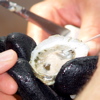Non-Native Oysters
As part of its mission to provide objective scientific advice to regulatory and management agencies, researchers at the Virginia Institute of Marine Science played a central role in the multi-year, multi-institutional effort to evaluate the potential use of non-native oysters in Chesapeake Bay. VIMS research focused on both native and non-native species, with a clear distinction between evaluation of two separate goals—restoration for ecological purposes and restoration and maintenance of a commercially viable fishery.
Although policymakers ultimately decided against the introduction of non-native oysters for restoration or aquaculture, the evaluation process led to a discovery that has revolutionized aquaculture of native oysters in the Bay: the use of spawnless triploid oysters, animals that can be harvested in summer and whose rapid growth helps outpace disease.
 |
BackgroundVIMS began evaluating non-native oysters in 1995, when the Virginia General Assembly charged us with developing a strategic plan for shellfish research, including testing of non-native species. |
 |
Non-Native Oyster TimelineA synopsis of significant milestones in the evaluation of non-native oysters in Chesapeake Bay. |
 |
Information ProductsA one-stop shop for research findings, reports, web pages, and other information sources concerning non-native oyster research in the Chesapeake Bay region. |
